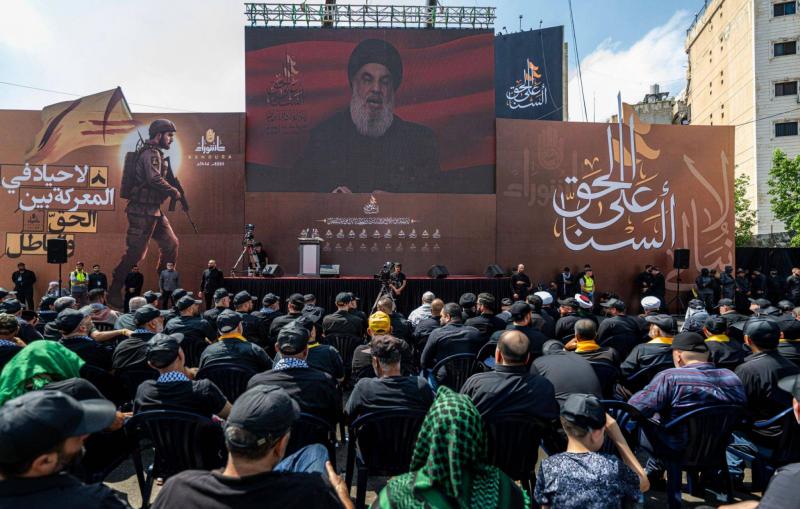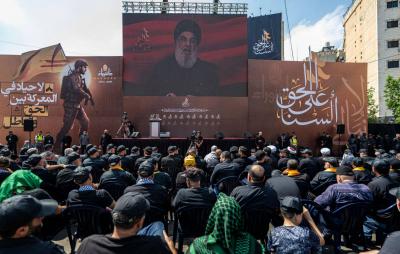The speech delivered by Hezbollah Secretary-General, Sayyed Hassan Nasrallah, last Tuesday at the commemorative ceremony for the martyrdom of Hezbollah leader Fouad Shukr, known as Sayyed Mohsen, stands out as one of the most significant statements made by Nasrallah recently. Its importance lies in its pivotal nature, addressing the past, present, and future. Nasrallah's address concentrated on three main topics: first, an evaluation of the ongoing battle in Gaza and the South, along with his perspective on them; second, an assessment of the current international and regional situation; and third, the party’s vision for the forthcoming phase. This is crucial as it practically divulges Hezbollah's thought and direction, which may reflect and impact events in the coming decade in Lebanon. The party is presently positioned as the major power broker influencing events in Lebanon and its surrounding geopolitical area, following Syria's withdrawal from this role for various reasons recently.
Events and positions have demonstrated that Nasrallah has now become the spokesperson and principal representative for the axis of allied or supportive forces directed by Iran in the region, which some refer to as the axis of resistance. The narrative presented by Nasrallah appears coherent for the most part, and much of the analysis he provided about the current events seems accurate. His remarks concerning the American and Western endorsement of Israeli actions against the Palestinian people are entirely correct. The United States and the majority of Western countries continue to grant Israel prior approval for its actions against the Palestinian populace. Furthermore, contrary to what the Palestinian Health Ministry has officially reported, the number of martyrs in Gaza has significantly exceeded these figures, as the reported numbers only include those who reached hospitals or health centers, had their names recorded, and were examined. However, the actual numbers are much higher, many of whom remain buried under the rubble.
Nasrallah asserted that the notion of a two-state solution is merely a mirage affecting certain parties and Arab states. This is entirely realistic. He contended that Israel would not agree to a Palestinian state, even if just in Gaza, which is accurate. He also suggested that Israel might evict residents of the West Bank towards Jordan, which is plausible, especially considering the settlements that now house hundreds of thousands of settlers. Therefore, as Nasrallah indicated, the gamble on a two-state solution by some Arab parties with Israel’s approval is a bet on a mirage. This analysis is not exaggerated; it is a reflection based on facts.
However, what must be emphasized is the conclusion and perception that Nasrallah arrived at, claiming that "the fundamental project is the true axis of resistance, which advocates for Palestine from the river to the sea, while other projects in the middle will dissolve, as they have no future since they lack reality or truth." Here, Nasrallah sets aside all other projects to uphold the banner of complete liberation of Palestine from "the river to the sea," as part of what he terms the resistance axis, or as others refer to it, the Iran axis or the axis of resistance.
On the regional front, Nasrallah clarified that Israel considers the Shebaa Farms and Kfarshouba hills as Israeli territory, having almost annexed them. Most of Nasrallah's analysis and assessment of Israeli and American behaviors seem correct and realistic. However, the real issue is not the analysis and assessment put forth by Hezbollah's Secretary-General but rather the conclusions he has drawn and the orientations he has declared. His assertion that the resistance axis aims to reclaim Palestine from the river to the sea expresses a general hope shared by many Arab citizens, but simultaneously, it prevails as an overstatement, relying on inflated and unrealistic assumptions about current and future circumstances amidst ongoing international and regional balances that appear to persist for an extended time.
This legitimate aspiration, of course, entails viewing Lebanon as part of the resistance axis controlled and managed by Iran. Though he has not explicitly stated this, the context of his remarks indicates so! Furthermore, Nasrallah's reference to the Shebaa Farms and Kfarshouba hills suggests he intends to convey that the resistance will continue to strive for the liberation of these territories, even if Syria does not officially recognize them as Lebanese.
The fundamental problem here lies not in the analysis, which closely approximates reality, but in the inference and assumption that Lebanon and the Lebanese people at large agree and are prepared to implement these conclusions, orientations, and policies. These policies are neither officially nor popularly endorsed in Lebanon, nor are they agreed upon in accordance with the National Accord Document, which the Lebanese people collectively accepted. They require a Lebanese majority or consensus that is currently nonexistent or unattainable for implementation. Also, these policies lack legal endorsement and fall outside official and constitutional frameworks.
While Sayyed Nasrallah may be correct in his political and strategic analyses, he overlooks the fact that such aspirations necessitate the approval, consensus, and satisfaction of a majority or more of the Lebanese populace, which must comply with constitutional and legal pathways that the Lebanese people have endorsed, adhere to, and firmly hold onto. It will not be easy to bypass or leap over these established structures.
Thus, for Nasrallah to propose shifting Lebanon from the idealized "Switzerland of the East"—a previously promised state that has now been shattered, as referenced by Lamartine in the 19th century—to a "Hanoi of the Middle East," is a matter that may be considered but he has failed to recognize that he cannot unilaterally transform Lebanon into this new status without achieving the majority consent and approval of its own people, through adherence to legalities and respect for the constitution, rather than through coercion.




